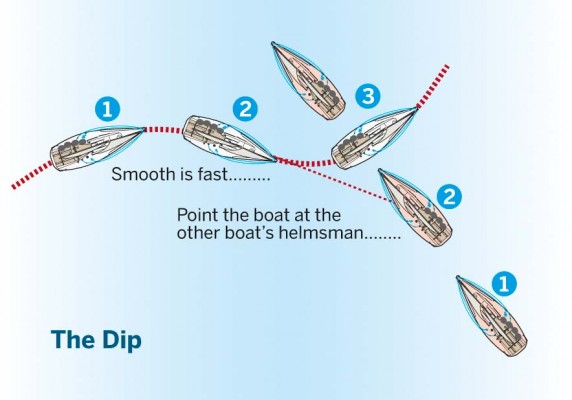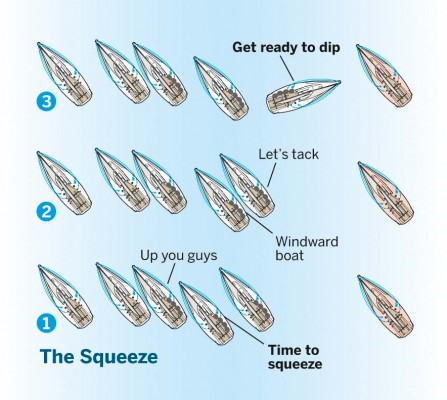Dipping and squeezing are essential techniques for untangling yourself from the competition, especially on the first upwind leg. Jonty Sherwill asked top match racer Ian Williams for his top tips
Even if you get clear air off the start line it’s likely there will be other boats close by on either side and the one to leeward might already be in squeeze mode caused by other competitors to leeward.
Meanwhile, you may also be dealing with a fast boat to windward and so your smart position can soon be under threat, with the imminent risk of dropping behind into dirty air.
It’s time to change mode, but what do you do?
You need height to match the boat on your lee bow, but sailing high means lower speed, with the prospect of the windward boat cruising over the top of you. Concerted early action and good crew work will be needed to prevent this, with the ultimate goal of forcing that windward boat to tack away.
Mastering this technique will help you maintain position in the front rank of the fleet, giving you better tactical options as the race progresses. But a windward boat forced to tack away might now be dipping sterns.
Once again communication between helmsman, tactician and trimmers is central to maximising boat speed during each dip to help minimise losses, and with luck before long a new lane of clear air will be found for a second bite at the cherry.
See also our 5 tips on trimming your headsail for power and pace
1. Minimise the damage
Before the dip consider what the starboard boat is likely to do. If you are near the port layline, they are likely to tack on your lee-bow, in which case you will need to do a late dip to prevent this or at least minimise the damage.
If they are likely to continue, you can dip earlier which will make it easier to be smooth and on a close-hauled course as you pass their transom.
2. Early call for dipping
An early call from the tactician for the dip and the size of it [the alteration of course] is important so that the helmsman, trimmers and grinders can be prepared. Last-second calls cost more time and maintaining control in gusty conditions is vital as you approach the stern of the starboard-tack boat. An under-trimmed jib and an over-trimmed mainsail can make steering more difficult and can spell disaster if the boat spins into a broach.
3. Smooth is fast
The goal when dipping is to be back on a close-hauled course as you pass the transom of the starboard-tack boat. Make sure you come all the way down in one movement and then immediately start a smooth turn back up while winding the sails in.
One trick is to point the bow at the other boat’s helmsman, which seems to be a good rough guide for how far to come down and then how quickly to come back up.
4. Preparing to squeeze
The most important information is the relative speed. Unless you are well bow forward, you never want to sail slower than the boat to windward as they may either roll you or convert that extra speed into height later. This sometimes requires a little patience, but as soon as you are faster, you can squeeze up and make it very hard for the windward boat that wants to put the bow down to build speed.
5. The high groove squeeze
It is important to have somebody on the rail calling the ‘relatives’ so the helmsman can focus on sailing a high groove.
We call relative speed first (see point 4), then relative height, then whether we are “getting to them” – ie going to squeeze them off rather than get rolled. It is also important to know from the tactician how much of a hurry you are in to get rid of the other boat – eg maybe you are approaching a layline.
This is an extract from a feature in Yachting World October 2014 issue






